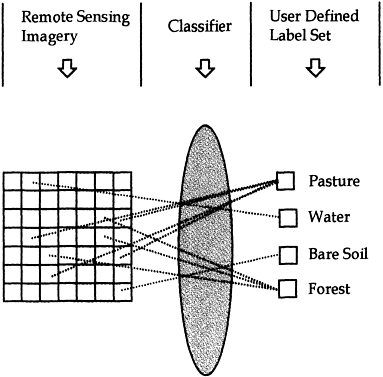268.
| [Cover] [Contents] [Index] |
Page 4

Figure 1.1 The concept of the classifier as a link between an image (left) and a set of labels (right).
forward neural net has an equally important impact on performance of the network.
The aim of this book is to provide a survey of pattern recognition methodology for use with remotely sensed imagery. Besides describing traditional approaches, more advanced techniques using artificial neural networks and fuzzy theory are introduced, and considerable space is devoted to the discussion of textural and contextual features. Some particular issues, such as pattern recognition using multiple data sources and the analysis of mixed pixels are also illustrated.
In the main part of this introductory chapter, the principles underlying remote sensing in the optical and microwave regions of the spectrum are described. Some important pre-processing techniques, such as corrections for atmospheric and topographic effects and noise filtering models are also presented. These techniques are helpful in improving thematic accuracy in some kinds of applications, for example, in change detection. Readers with an advanced knowledge of remote sensing principles may find the content of this chapter to be elementary, and they are recommended to skip to Chapter 2.
| [Cover] [Contents] [Index] |
EAN: 2147483647
Pages: 354